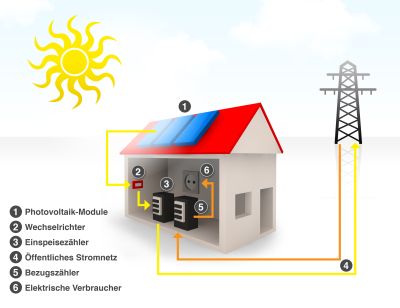More and more often, people use solar energy to save energy costs and reduce the burden on the environment. But how does such a solar system actually work? The function of a solar system is basically the same, whether it is a small solar system on a single-family house or an industrial plant. In principle, a grid-connected photovoltaic solar system works quite simply: As light falls on the solar cells, they generate direct current from it. The individual solar cells are interconnected to form larger solar modules. The individual solar modules are in turn connected together to form a solar generator. The generated direct current is converted to alternating current by the inverter. Thanks to the conversion, the alternating current can be fed directly into the public or privately used electricity grid, thus reducing either one's own electricity costs.
How does the single solar cell of a photovoltaic solar system work?
Nearly 95 percent of all solar cells are made from the quartz sand silicon (Si). Silicon (Si) is one of the most common natural elements found in the earth's crust. Silicon is considered to be inexhaustible. To form a silicon wafer from quartz sand - the natural source of silicon - the quartz sand must first be cleaned and crystallized. The finished product is then sawn into slices, selectively contaminated and provided with conductive tracks. These are needed for current transport.
When light falls on the silicon wafer, electrons are released. In order to be able to use these electrons, the top and bottom of each individual cell must be specifically contaminated with different foreign atoms. Boron (Br) and phosphorus (P) are frequently used here. Thanks to the targeted contamination of the cell, the electrons (negative charge carriers) collect on one side and the protons (positive charge carriers) on the other. In this way a plus and a minus pole are created, which is comparable to a battery. If a consumer device is connected subsequently, the current flows.
The small cells are so functional that they can generate current even at low light intensities, such as those that occur in bad weather or under cloudy skies. However, the current intensity is always proportional to the incident light intensity. By analogy, this means:
The higher the solar radiation, the more solar power is produced by the photovoltaic system.
However, the voltage of the solar cell behaves independently of the incidence of light or solar radiation. The voltage of a silicon cell is continuously 0.6 volts. However, the current depends on the size of the cell. A common solar cell with a dimension of 15 x 15 centimeters generates on average about 5.5 amperes of current. At full light incidence, a single cell has an output of about 3.4 watts.
How does the module of a solar system work?
The solar modules of a photovoltaic system convert sunlight into electrical energy. The light from the sun causes an electrical voltage when it hits the solar cell. This is already picked up at the surface. In a solar module of a photovoltaic system, several solar cells are electrically interlaced with each other. The electrical voltage is added together in series connection. Each individual cell has about 0.6 volts.
A common module with about 60 cells generates a module voltage of about 36 volts in total in this way. Solar modules made of crystalline silicon (Si) are most commonly used. High-purity silicon (Si), which is obtained from quartz sand, is further processed for this purpose.
The efficiency of a solar module is between 11 and 16 percent. For example, modules made of crystalline silicon (Si) are used as standard on roof systems. If thin-film modules are used, the efficiency is considerably lower. The highest efficiency for thin-film modules is 9 percent. Due to their extremely low cost, thin-film modules are particularly suitable for the operation of large-scale systems, where the amount of space required is of secondary importance.
Functionality of the power storage for PV systems
In principle, a PV electricity storage system works in the same way as the accumulators of a car battery. When charging, the accumulators of the electricity storage unit convert the electrical energy obtained from solar energy into chemical energy. If electricity is now required, the accumulators convert the chemical energy in the storage unit back into electrical energy. If the accumulators are discharged, they can be recharged. Most electricity storage units allow several thousand charging cycles.

